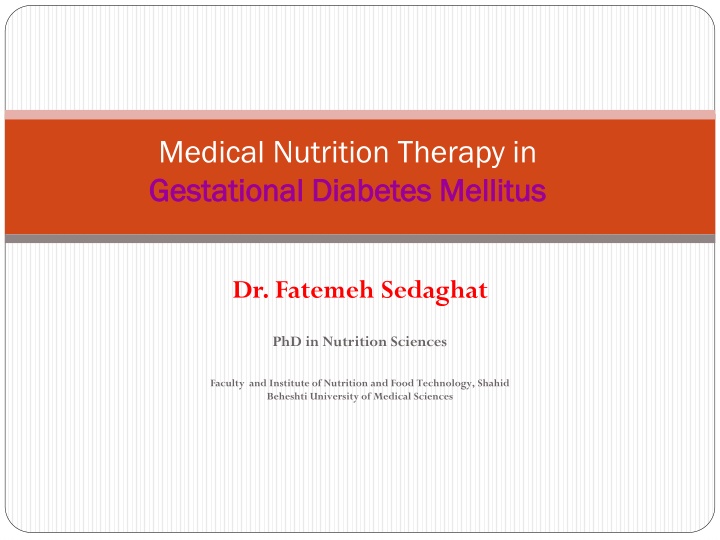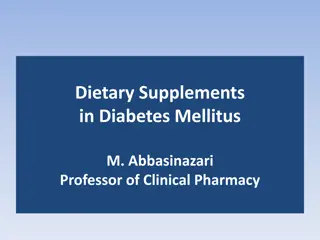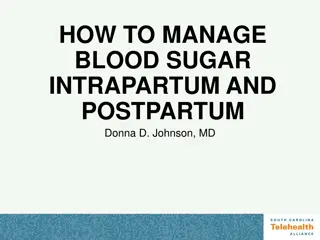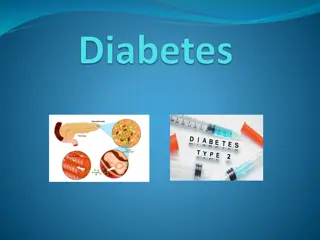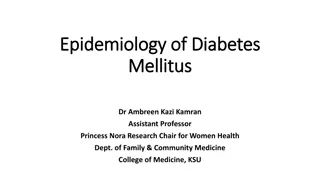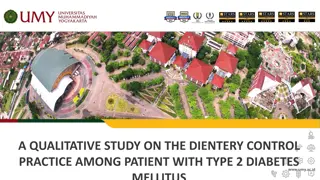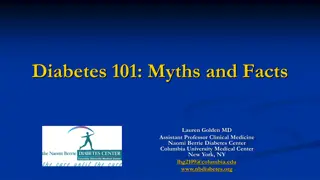Gestational Diabetes Mellitus: Overview and Risk Factors
Gestational Diabetes Mellitus (GDM) is defined as any level of glucose intolerance first detected during pregnancy, affecting approximately 7% of pregnancies globally. In Iran, GDM prevalence varies between 1.3% to 10%. Factors like age, BMI, weight gain, and family history influence GDM development. Pathophysiological changes in insulin sensitivity occur throughout pregnancy due to hormonal fluctuations. Understanding these aspects is crucial for managing GDM effectively.
Uploaded on Aug 30, 2024 | 8 Views
Download Presentation

Please find below an Image/Link to download the presentation.
The content on the website is provided AS IS for your information and personal use only. It may not be sold, licensed, or shared on other websites without obtaining consent from the author.If you encounter any issues during the download, it is possible that the publisher has removed the file from their server.
You are allowed to download the files provided on this website for personal or commercial use, subject to the condition that they are used lawfully. All files are the property of their respective owners.
The content on the website is provided AS IS for your information and personal use only. It may not be sold, licensed, or shared on other websites without obtaining consent from the author.
E N D
Presentation Transcript
Medical Nutrition Therapy in Gestational Diabetes Mellitus Gestational Diabetes Mellitus Dr. Fatemeh Sedaghat PhD in Nutrition Sciences Faculty and Institute of Nutrition and Food Technology, Shahid BeheshtiUniversity of Medical Sciences
Definition & Worldwide Prevalence of GDM Definition & Worldwide Prevalence of GDM GDM is defined as any degree of glucose intolerance with onset or first recognition during pregnancy Approximately 7% of all pregnancies are complicated by GDM ranging from 1 to 14% depending on the population studied the diagnostic tests more than 200,000 cases annually Diabetes care, 2009 2
Prevalence of GDM in Iran Prevalence of GDM in Iran According to 14 studies from 1992-2007, the prevalence of GDM ranged between 1.3% to 10% in different regions of Iran. 3 Khoshniat, 2009
Khoshniat N, Iranian Journal of Diabetes and Lipid Disorders; 2009 Dr. Mirmiran / SBMU Slide 4
Pathophysiology Pathophysiology In first trimester and early second trimester, increased insulin sensitivity occurs due to relatively higher levels of estrogen. in late second and early third trimesters, increased insulin resistance and reduced sensitivity due to a number of antagonistic hormones especially, placental lactogen, leptin, progesterone, prolactin, cortisol and adiponectin. 5
Risk Factors for Development of GDM Risk Factors for Development of GDM Age >25years BMI >25kg/m Increased weight gain during pregnancy Previous history of large for gestational age infants History of GDM during previous pregnancies Ethnic group ( East Asian, Pacific Island ancestry) Elevated fasting or random blood glucose levels during pregnancy Family history of diabetes in first degree relatives History of type I or type II Diabetes Mellitus 6 Cheung,2009
GDM GDM Complication Complication Adverse Pregnancy Outcomes: macrosomia shoulder dystocia Jaundice polycythemia respiratory distress Hypocalcemia Risk of developing diabetes later in life 7 Cheung,2009
GDM Complication GDM Complication Maternal Complication : Weight gain Maternal hypertensive disorders Miscarriages Third trimester fetal deaths Cesarean delivery (due fetal growth disorders) Long term risk of type 2 diabetes mellitus 8 Cheung,2009
GDM Screening GDM Screening Screening should be done during the 24th to 28th week of pregnancy using a 100-g oral glucose tolerance test (OGTT). Fasting glucose of more than 92 mg/dL I-hour glucose of more than 180 mg/dL 2-hour glucose of 153 mg/dL or more 3-hour glucose of 140 mg/dL or more 9
Maternal Dietary Patterns and GDM Maternal Dietary Patterns and GDM The results of recent systematic reviews showed that adherence to a healthier dietary pattern, like Mediterranean dietary pattern, and reducing the intake of sugar sweetened cola, potatoes, fatty foods, sweets can decrease the incidence of GDM, especially in women at higher risk and before getting pregnant. 10 D. A. Schoenaker, 2016
Western dietary pattern was high in sweets, jams, mayonnaise, soft drinks, salty snacks, solid fat, high-fat dairy products, potatoes, organ meat, red meat, processed foods. Western dietary pattern was associated with increased risk of GDM. 11
Medical Nutrition Therapy Medical Nutrition Therapy (MNT) in GDM (MNT) in GDM 12
Medical Nutrition Therapy (MNT) Medical Nutrition Therapy (MNT) The American Diabetes Association recommends that all women with GDM receive nutrition counseling by a registered dietitian (RD). MNT is the primary therapy for 30 90% of women diagnosed with GDM. Individualization of MNT depending on maternal weight and height, physical activity level, and lifestyle is recommended. 13 Reader,2007
Medical Nutrition Therapy Medical Nutrition Therapy (cont ) (cont ) Goals: Achieve normoglycemia Recommended treatment targets Test Gestational Diabetes (mg/dl) Fasting plasma glucose 65-95 I hr postprandial <140 2 hr postprandial <120 14 ADA,2004
Medical Nutrition Therapy (cont) Goals: Providing the required nutrients for normalfetal growth and maternal health. Prevent excessive maternal weight gain, particularly in women who are overweight or have gained excess weight in pregnancy. Prevent ketosis. 15
Medical Nutrition Therapy Medical Nutrition Therapy (cont (cont ) ) Include: Nutrition therapy Exercise Self-monitoring of blood glucose (SMBG) Pharmacologic therapy Education 16
Nutrition Nutrition Therapy Therapy 17
Efficacy of Dietary Therapy for GDM Efficacy of Dietary Therapy for GDM Nutrition intervention for GDM has been recognized as the cornerstone of therapy. In patients receive diet therapy: Fewer patients require insulin therapy Decrease HbA1c lower serious perinatal complications among the infants: lower perinatal mortality lower % large-for-gestational-age Less macrosomia 18 Crowther ,2005, Reader,2006, Cheung,2009
Nutrition Therapy Nutrition Therapy (cont (cont ) ) All women should receive individualized counseling Food plan should be individualized & culturally appropriate to provide adequate calories & nutrients to meet the needs of pregnancy and consistent with the blood glucose goals 19 Cheung,2009
Nutrition Therapy Nutrition Therapy (cont ) (cont ) Do the Institute of Medicine and other recommendations for weight gain and calorie intake apply to the woman with GDM? Weight gain during pregnancy for women with GDM should be similar to that of women without diabetes 20 Reader,2007
Nutrition Therapy Nutrition Therapy (cont ) (cont ) weight-gain recommendations based on prepregnancy BMI ) BMI (kg/m2 weight-gain (kg) Underweight 18.5 normal 18.5 25.0 overweight 25 29.9 Obese >29 12-18 11.3 15.3 kg 6.8 11.3 kg 7 kg 21 (Institute of Medicine s Nutrition for Pregnancy 1990)
Nutrition Therapy Nutrition Therapy (cont ) (cont ) Overweight and obese women: Severe calorie restriction <1500 calories per day or 50% restriction increases ketonuria and ketonemia. American Diabetes Association have suggested: 22 ADA,2000
Nutrition Therapy Nutrition Therapy (cont (cont ) ) Calorie formulas have been suggested in articles and guidelines for GDM: 35 40 kcal/kg for underweight 30 35 kcal/kg for normal weight 25 30 kcal/kg for overweight 23 25 kcal/kg (pregravid weight) for obese 23 Reader,2007
Nutrition Therapy Nutrition Therapy (cont ) (cont ) Macronutrient Intake Carbohydrate (CHO):50 to 55% kcal intake Protein:20-25% kcal intake Fat:25-30% kcal intake 24 Cheung,2009
Nutrition Therapy Nutrition Therapy (cont ) (cont ) Carbohydrate The 2002 Dietary Reference Intake Report set a minimum level of 130 g/day for non-pregnant women and 175 g/day for pregnancy; this is an additional 45 g carbohydrate for fetal brain development and functioning. An evening snack is usually needed to prevent accelerated ketosis overnight. 25 Cheung,2009
Nutrition Therapy Nutrition Therapy (cont ) (cont ) Carbohydrate Carbohydrates are not as well tolerated at breakfast as they are at other meals because of increased levels of cortisol and growth hormones. Initial food plan may have approximately 30 g of carbohydrate at breakfast. To satisfy hunger, protein foods can be added because they do not affect blood glucose levels. 26 Cheung,2009
Nutrition Therapy Nutrition Therapy (cont ) CHO are an important dietary source of energy, vitamins, minerals & fiber content. CHO is the main nutrient that affects postprandial glucose levels. (cont ) CHO intake can be manipulated by: Controlling the total amount of CHO Distribution of CHO over several meals and snacks Type of CHO Dr. Mirmiran / SBMU 27 Reader,2007
Nutrition Therapy Nutrition Therapy (cont ) (cont ) The ADA Standards of Medical Care state : Glycemic Index (GI) can provide additional benefit to total carbohydrate control GI = (iAUCtest food/iAUCglucose) x 100 Foods with a low GI (<55) produce a lower postmeal glucose elevation Foods with a high GI (>70) show higher postprandial glucose values 28 Reader,2007
Nutrition Therapy Nutrition Therapy (cont ) (cont ) Glycemic load (GL) GLFood = GIFood x amount (g) of available carbohydrateFood per serving/100 high with GL 20 intermediate with GL of 11-19 low with GL 10 29 Reader,2007
Nutrition Therapy Nutrition Therapy (cont ) (cont ) The glycemic index may have some benefits, but may be problematic as well. Concerns include: Single food items, rather than combinations of foods, can impact blood sugar differently Doesn't consider all variables that affect blood sugar, such as how food is prepared or how much is eaten Only includes foods that contain carbohydrates Doesn't rank foods based on nutrient content, foods with a low GI ranking may be high in calories, sugar or saturated fat. 30
Nutrition Therapy Nutrition Therapy (cont (cont ) ) 10 Low-Glycemic Fruits for Diabetes Cherries (GI:20, GL:6) Grapefruit (GI:25, GL:3) Dried apricot (GI:32, GL:9) Pears (GI:38, GL:4) Apples (GI: 39, GL:5) Oranges (GI:40, GL: 5) Plums (GI: 40, GL: 2) Strawberries (GI:41, GL:3) Peaches (GI: 42, GL: 5) Grapes (GI: 53, GL: 5) 33
Nutrition Therapy Nutrition Therapy (cont ) (cont ) GI GI or or GL? GL? Though the GL balance any meals containing watermelon foods to minimize any potential blood sugar spikes. GL of watermelon watermelon is low, be sure to watermelon with low-GI GI WatermelonGI: 72, GL: 2 34
Nutrition Therapy Nutrition Therapy (cont (cont ) ) Choose complex CHO contain Fiber: Soluble (legumes, oats, oat bran, barley, nuts, fruits) Insoluble (whole grain breads, cereals and some vegetables, seeds) Both: Increase satiety Slowing absorption time Lower glycemic index 35 Reader,2007
Nutrition Therapy Nutrition Therapy (cont (cont ) ) Carbohydrate Counting Works as follows: A dietitian determines a person s dietary needs The individual is given a daily CHO allowance Divided into a pattern of meals & snacks according to individual preferences The carbohydrate allowance can be expressed in grams or as the number of carbohydrate portions allowed per meals 36
Nutrition Therapy Nutrition Therapy (cont ) (cont ) Carbohydrate Counting Emphasis is given to spreading the dietary intake over six meals daily: 3 main meals 3 snacks Distribution of CHO in daily meals meals Breakfast Snack1 Lunch Snack2 Dinner Snack3 CHO% 15% 12.5% 25% 12.5% 25% 10% 37
Nutrition Therapy Nutrition Therapy (cont ) (cont ) 38
Nutrition Therapy Nutrition Therapy (cont ) (cont ) Example: 35 year old woman diagnosed with GDM, at weeks 28 of her pregnancy, Pre-pregnancy weight: 90, height 1.70, BMI: 31 The nutrition prescription is the following: Calories: 2000 Carbohydrates (50%): 250 g Protein (20%): 100 g Fat (30%): 66 g Meals Breakfast Snack1 Lunch Snack2 Dinner Snack3 CHO% 15% 12.5% 25% 12.5% 25% 10% gram 38 32 62 32 62 25 39
Nutrition Therapy Nutrition Therapy (cont ) (cont ) Fat intake: Less than 10 % SFA (animal fat contained in cuts of meat; dairy products, such as milk, butter and cheeses; and the skin of chicken, turkey, and other poultry) Up to 10 % PUFA (are found in fish, soybean products, walnuts, and flaxseeds.) The remainder derived from MUFA (are found in avocados, nuts, seeds, olive oil, canola oil, and peanut butter.) 40 Cheung,2009
Nutrition Therapy Nutrition Therapy (cont ) (cont ) Protein intake: Dietary proteins and amino acids are important modulators of glucose metabolism, and a diet high in protein may impact glucose homeostasis by promoting insulin resistance and increasing gluconeogenesis. Most protein sources don t have carbohydrates and won t raise blood sugar, but be sure to check vegetarian sources of protein, such as beans and legumes, which can contain carbohydrates. 41 Cheung,2009
Nutrition Therapy Nutrition Therapy (cont ) (cont ) Nutrient needs There is no indication that women with GDM should not follow the same guidelines for nutrient intakes for all pregnant women (Dietary Reference Intakes for pregnancy 2001) 42 Reader,2007
Exercise Exercise Exercise is an obvious adjunct therapy to MNT for women with GDM to improve maternal glycemia. light and moderate intensity activities such as walking for 20 30 min/day: can be safely encouraged, modest improvements in glycemic control might be achieved 44 Reader,2007
Recommendations Recommendations Breakfast Tips: Eat a small breakfast. Eat whole-grain bread products. Eat a food that has protein. This will help you to: feel full, get enough protein for you and your baby, control your blood sugar. Do not eat cereal or fruit. Do not drink fruit juice at breakfast or any other time of the day. Fruit juice raises your blood glucose very quickly. 45
Recommendations Recommendations Fat Tips: Fat contains calories to help supply energy to you and your baby. Fat helps your body absorb vitamins A, D, E and K. Fat also gives you essential fatty acids, which help your baby's brain and nervous system develop. It is important to focus on eating healthful fats. The following foods are good sources of healthful fats: Most nuts and seeds Peanut butter (natural or trans fat-free) Cooking oils (olive, canola, peanut or flaxseed) Avocados Fatty fish (salmon or trout) 46
Recommendations Recommendations Tips to remember: If you are hungry, add vegetables or a protein food to your carbohydrate snacks. Focus on eating healthful fats. If your blood glucose is high when you wake up, have a bedtime snack that includes both protein and carbohydrates. This will help keep your blood glucose in check during the night. 47
CONCLUSIONS CONCLUSIONS Women with GDM (and women with preexisting diabetes) should be encouraged to breastfeed because breastfeeding is associated with a reduced incidence of future T2DM (Stuebe, 2005). For women with GDM who are overweight or obese or with above-recommended weight gain during pregnancy, weight loss is advised after delivery. Weight loss reduces the risks of recurrent GDM or future development of T2DM. 48
CONCLUSIONS CONCLUSIONS The food plan should be designed to: Fulfill minimum nutrient requirements for pregnancy Achieve glycemic goals without weight loss and ketonemia Be culturally appropriate and individualized to take into account the patient s body habitus, weight gain, and physical activity 49
